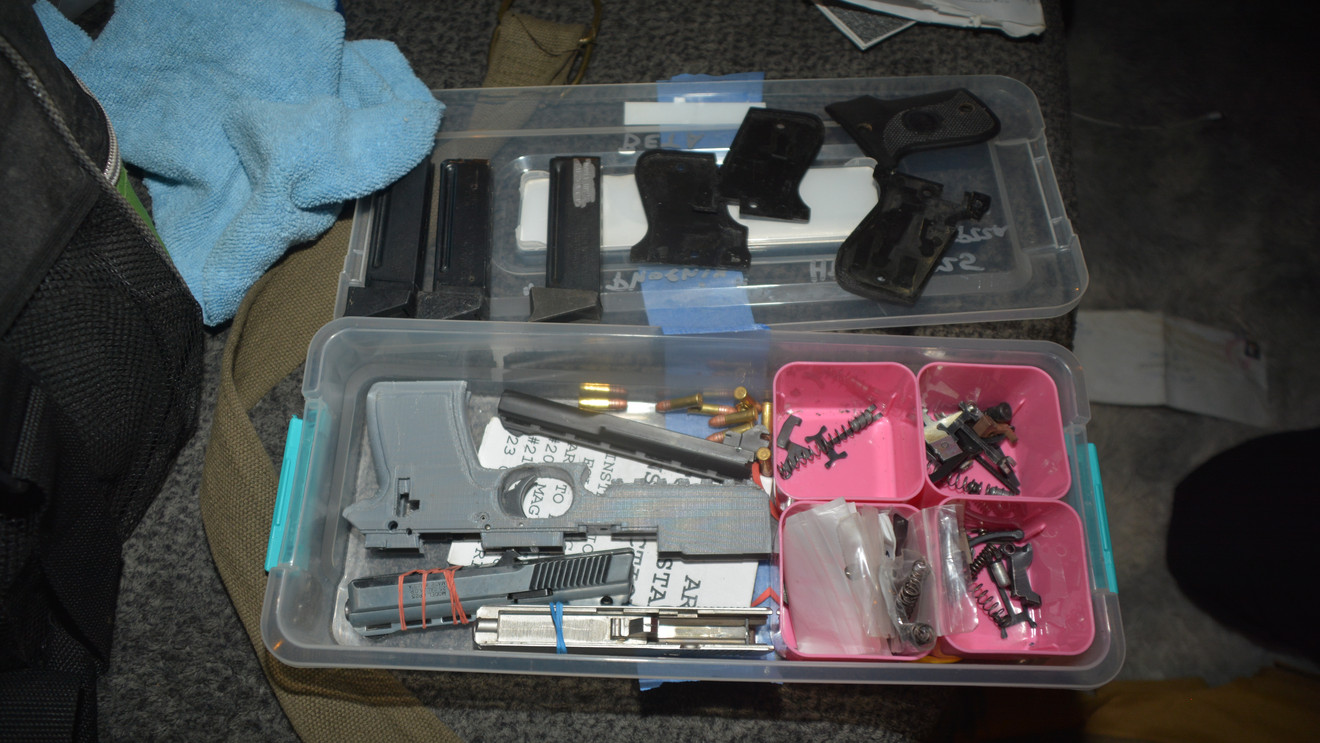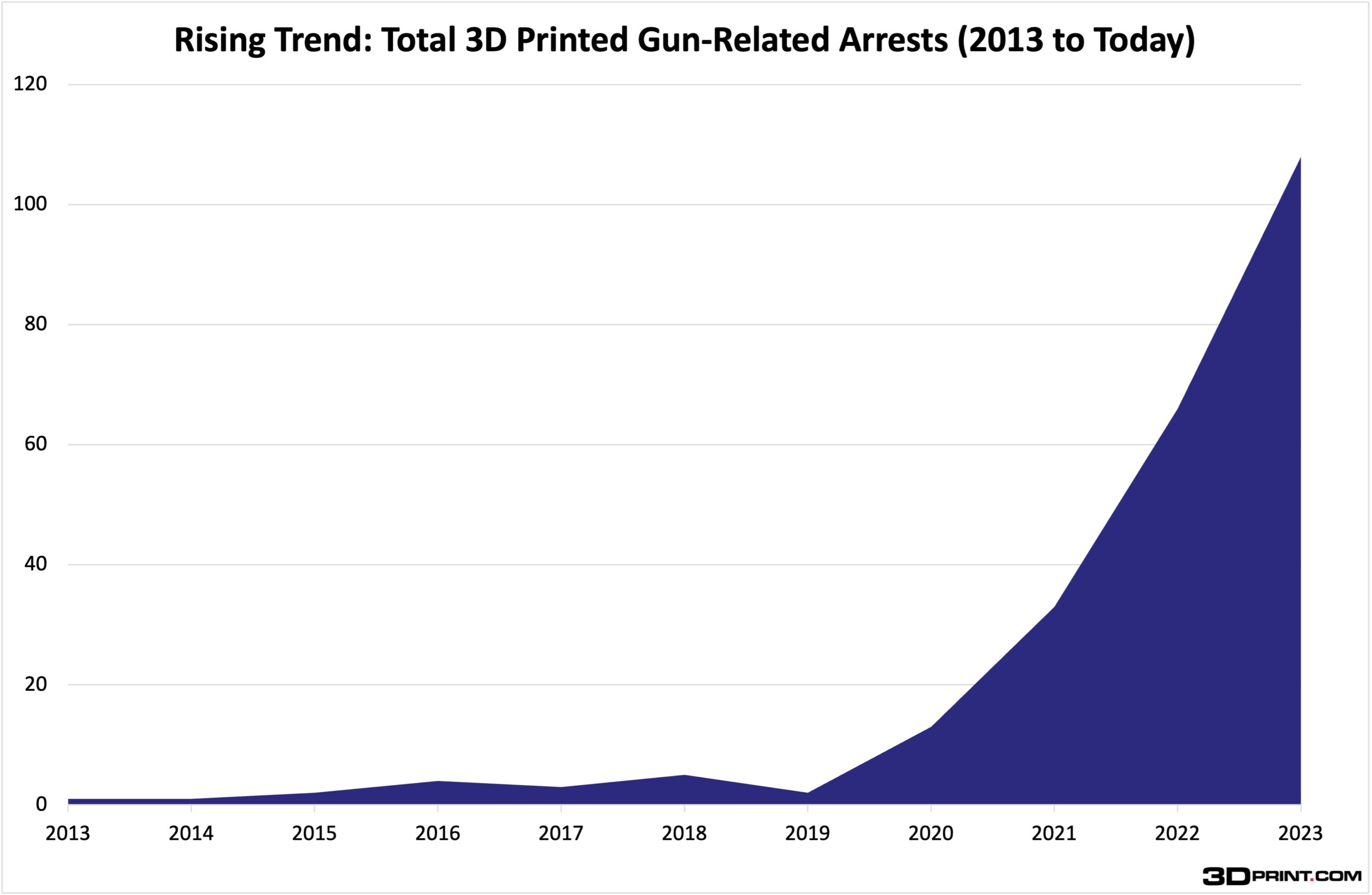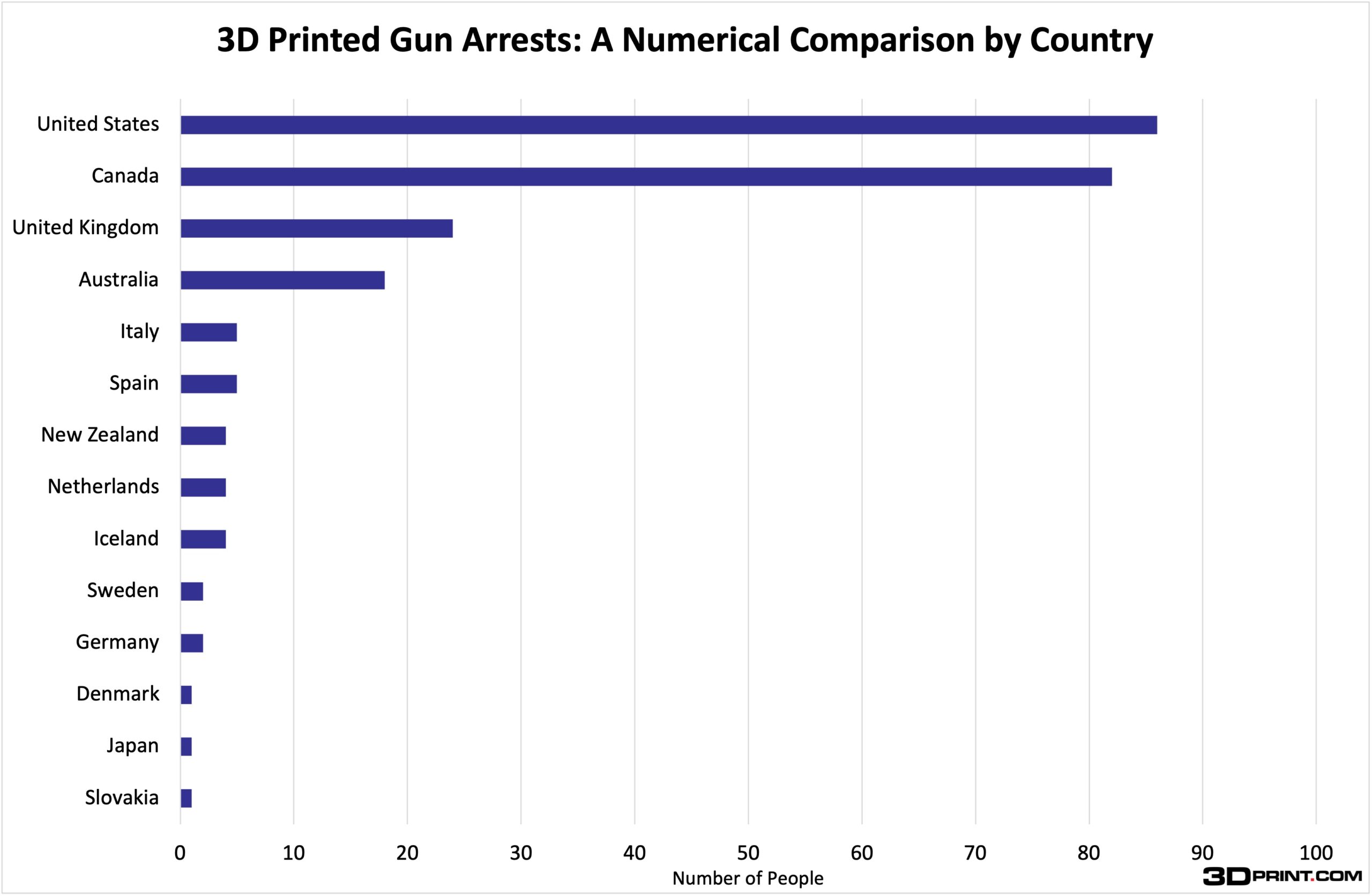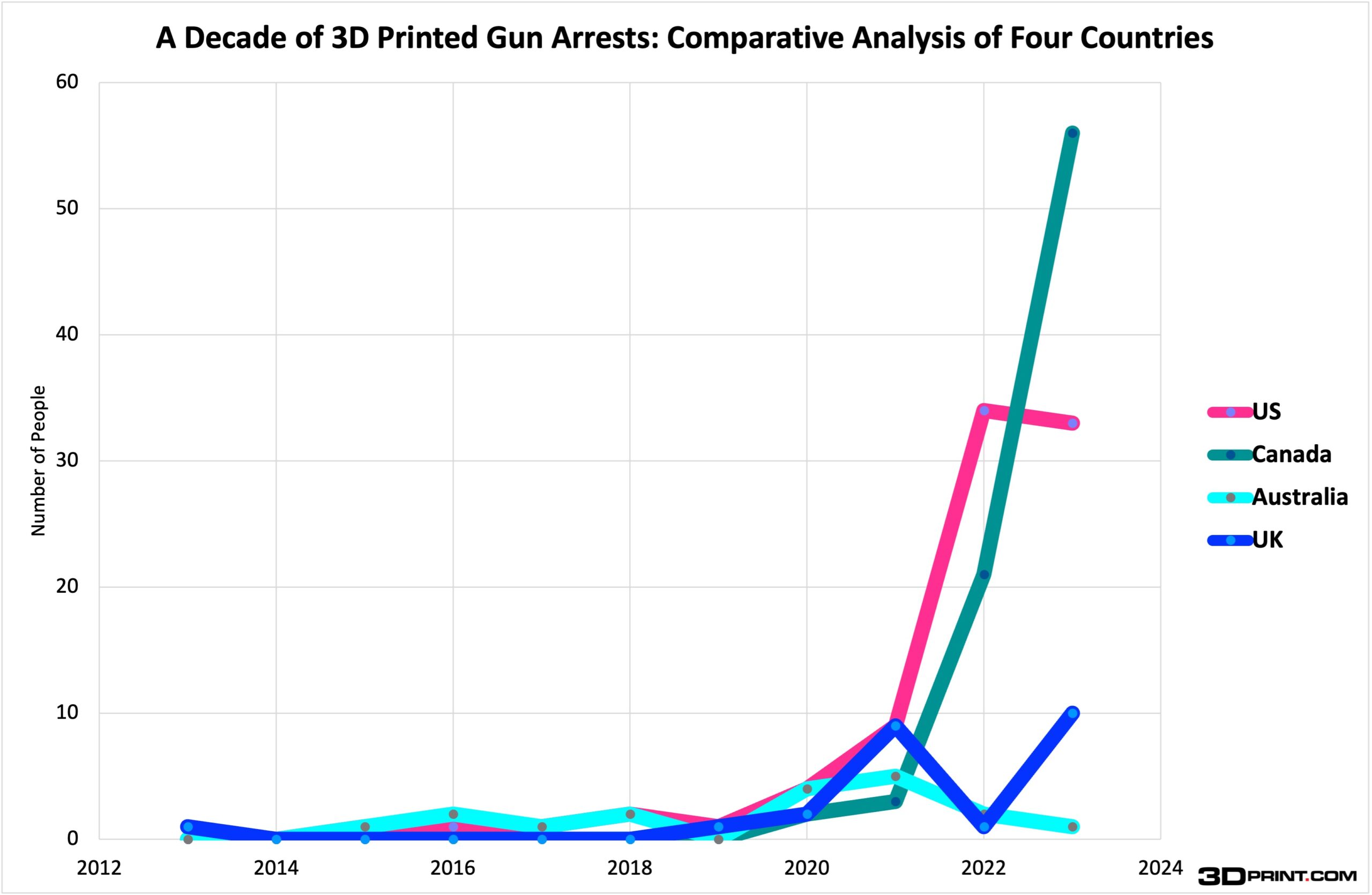In the fight against illicit firearms, the growing number of arrests related to 3D printed guns is a red flag rising yearly. Last year, 3DPrint.com’s report shed light on the tripling of arrests in less than two years. Today, the presence of 3D printed guns in arrest statistics is growing.
From the lone arrest of a British man in 2013 – suspected of 3D printing a gun in what’s thought to be first ever seizure of a next-generation weapon – to a shocking 108 in the first half of 2023 alone, the surge in arrests paints a picture of how 3D printed firearms have shifted from a minor concern to a more noticeable phenomenon in crime statistics. The over 100-fold increase in a decade underscores the accelerating interest that criminals and gangs have developed in these untraceable and undetectable weapons, also known as ghost guns.
Reported incidents of 3D printed guns used in criminal activity have generally been low and scattered globally. For example, a 3D printed gun was used in a 2016 murder in the U.S., marking one of the first such instances. In Australia and the U.K., police seizures of 3D printed firearms have been part of numerous criminal investigations. However, tracking the full extent of their use in crime is challenging due to the difficulty in tracing these often unserialized weapons. Notably, 3D printed guns have evolved from basic, one-shot devices to more advanced, semi-automatic variants, mirroring their increased visibility in crime statistics.
In our 2022 report, the United States, Canada, and Australia emerged as the countries leading 3D-printed gun-related arrests, accounting for 44%, 18%, and 17% of our total count of arrests, respectively. These numbers highlighted a worrying trend predominantly affecting North America and Oceania, with Europe trailing behind. Fast-forward to 2023, the problem shows no signs of slowing down. In fact, with 108 arrests recorded in just the first half of the year, this upward trajectory is slated to surpass last year’s total of 66 arrests by a substantial margin.
This time around, the geographical distribution of arrests offers a new perspective. Since our initial total in 2013 up until today, North America has been leading the arrests with 166, followed by Europe, reporting 48 arrests. Oceania rounds out the top three regions with 24 arrests. Percentage-wise, the U.S., Canada, the U.K., and Australia now account for 36%, 34%,10%, and 8%, respectively, of the total arrests.
Also, the global landscape of laws surrounding 3D printed firearms has changed and evolved over the last few years. In the U.S., the issue of 3D printed firearms has sparked much debate. While it has traditionally been legal for individuals to manufacture their firearms, the convenience and elusiveness of 3D printed guns led to many legal battles. One example is New York, where lawmakers have proposed a new law that would make it a crime to manufacture a firearm using a 3D printer.
There are several laws regarding 3D printed weapons in other U.S. states. For example, California, Connecticut, Hawaii, Maryland, Massachusetts, and New Jersey have all implemented regulations encompassing restrictions on manufacturing and possession and the requirement for permanent metal components in 3D printed guns. New Jersey and Washington have laid down serial numbers and background check provisions in their laws. Pennsylvania and Rhode Island have proposed legislation with similar considerations, with Rhode Island emphasizing the importance of detectability by metal detectors.
 3D printed gun parts recovered in investigation into Tully man. Image courtesy of Onondaga County Sheriff’s Office.
3D printed gun parts recovered in investigation into Tully man. Image courtesy of Onondaga County Sheriff’s Office.Meanwhile, other countries have implemented more stringent regulations. In 2020, Canada passed a law banning assault-style weapons, including firearms whose frames or receivers are produced through a mold, pattern, or with 3D printing. Similarly, Australia, known for its strict firearm laws, made it illegal as early as 2015 to possess files that can be used to 3D print guns in New South Wales.
In the United Kingdom, existing firearm laws cover 3D printed guns, making it illegal to manufacture a weapon, including a 3D printed one, without a proper license. These countries’ aggressive stance toward 3D printed guns highlights their efforts to control this emerging threat. However, the effectiveness of these regulations is a matter of ongoing observation and study as the technologies for 3D printed firearms continue to advance and increase.
Many countries have some form of legislation permitting citizens to own firearms, usually with a range of restrictions and regulations in place. However, the constitutional right to bear arms, codified in the U.S. Second Amendment, is unique in its broad protections. No other country has a constitutional framework that precisely mirrors the U.S. First and Second Amendments, although many countries have some form of protection for free speech and the right to bear arms.
However, very few, if any, have both protections to the extent seen in the U.S. Constitution, particularly with the specificity of the Second Amendment’s right to bear arms. This unique combination has contributed to the specific legal and regulatory challenges faced by the U.S. in addressing 3D printed firearms. Primarily since the specifics of gun ownership — such as what types of guns are permitted, who can own them, and licensing — are often regulated on a state-by-state basis.
For instance, Canadian citizens can own firearms, subject to strict regulations like safety tests and background checks. In Switzerland, gun laws are more permissive than in many other European countries, partially due to the tradition of universal military service and the keeping of service weapons at home. However, certain types of firearms still require permits. In the Czech Republic, the constitution guarantees the right to own guns, but it is subject to obtaining a license.
Moreover, in many countries, the right to own firearms is heavily regulated and often requires licensing, background checks, and other measures that don’t align with the idea of freely downloadable and printable firearms. Therefore, it is generally illegal in most jurisdictions to manufacture a firearm without proper licensing, whether traditionally made or 3D printed, even for personal use.
While this issue is global, data from 2013 to 2023 show significant variances across countries. In the U.S., the number of arrests was consistently low from 2015 to 2019, with a maximum of just two arrests in 2018. However, starting in 2020, there was an evident increase. The numbers rose from four arrests in 2020 to 34 in 2022, nearly tripling in just two years. As of mid-2023, the U.S. has already seen 33 arrests, suggesting the trend continues unabated.
Canada presents a similar but even more pronounced pattern. After recording two arrests in 2020, the numbers surged dramatically, reaching 56 arrests by the first half of 2023, mainly due to a nationwide raid targeting the manufacturing and trafficking of 3D printed firearms. This indicates a more than twofold increase compared to the previous year.
In contrast, Australia has experienced a relatively steady number of arrests, fluctuating between zero and five annually from 2015 to 2022. However, the first half of 2023 has seen just one arrest, suggesting a possible decline in this trend. In the U.K., there was a noticeable spike of nine arrests in 2021 from just two in the preceding year. However, the numbers dipped to one in 2022 before soaring to ten in the first half of 2023.
These disparities underline that the issue of 3D printed firearms and their illicit use is not uniform worldwide. Instead, it is shaped by various local factors, including differences in legislation, enforcement, societal attitudes, and access to technology. As we move further into a more digitized decade, law enforcement worldwide has already expressed concern over the need to adapt and evolve their strategies to effectively combat this growing threat while maintaining freedom in countries where the production of 3D printed guns for personal use is permitted.
In the world of unlawful weapons production for criminal use, interest in 3D printed weapons is growing fast. These figures could be one of the reasons many nations have begun tightening their regulations and enforcement of 3D printed weapons.
Subscribe to Our Email Newsletter
Stay up-to-date on all the latest news from the 3D printing industry and receive information and offers from third party vendors.
You May Also Like
Gorilla Sports GE’s First 3D Printed Titanium Cast
How do you help a gorilla with a broken arm? Sounds like the start of a bad joke a zookeeper might tell, but it’s an actual dilemma recently faced by...
Nylon 3D Printed Parts Made More Functional with Coatings & Colors
Parts 3D printed from polyamide (PA, Nylon) 12 using powder bed fusion (PBF) are a mainstay in the additive manufacturing (AM) industry. While post-finishing processes have improved the porosity of...
$25M to Back Sintavia’s Largest Expansion of Metal 3D Printing Capacity Since 2019
Sintavia, the digital manufacturing company specializing in mission-critical parts for strategic sectors, announced a $25 million investment to increase its production capacity, the largest expansion to its operations since 2019....
Velo3D Initiates Public Offering in a Bid to Strengthen Financial Foundations and Drive Future Growth
Velo3D (NYSE: VLD) has been among a number of publicly traded 3D printing firms that have attempted to weather the current macroeconomic climate. After posting a challenging financial report for 2023,...



































